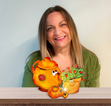Dawn Renee Stephens's Blog, page 2
June 19, 2023
7 Free Lessons in the Education for Character that Blooms Knowledge.
Education for character traits can be challenging. However, Little Pot, the main character in the lesson and a fruit-bearing vessel created by the potter brings clarity and simplicity to the task. Additionally, in these seven FREE lessons, children learn the fruit-bearing cycle and how to produce love, joy, peace, patience, kindness, goodness, faithfulness, gentleness, and self-control. Likewise, the activities perfectly blend fun and learning with understanding. The sixth lesson in this series is about the flower and how we can bloom knowledge that produces the fruit of the Spirit. So, let’s jump into Little Pot’s sixth lesson and continue learning about education for character traits.
Read more: 7 Free Lessons in the Education for Character that Blooms Knowledge.Why you should use Little Pot in education for character.First, let’s discuss why Little Pot is the perfect tool for teaching character traits. The seven lessons illustrate complex concepts in a way that’s easy to understand. Little Pot’s fruit-growing cycle can teach character traits such as identity, humility, integrity, relationships, and knowledge. Moreover, Little Pot is a tangible reminder of the creator’s love and care for us. Likewise, it symbolizes how God nurtures us, wants a relationship with us, and helps us grow into the people He wants us to be.
When you use Little Pot’s method of fruit growing, you’re helping others understand that character is not fixed or innate but something God cultivates and develops over time. Therefore, using this character education curriculum as a teaching tool develops the skills and attitudes needed to become the vessels God designed us to be. Each week, we will discuss one of the following lesson plans.
Lesson Plan 1: IdentityLesson Plan 2: Humility and How to Contain ItLesson Plan 3: Planting the Right SeedsLesson Plan 4: Strong and Upright IntegrityLesson Plan 5: Fostering Healthy RelationshipsLesson Plan 6: Blooming KnowledgeLesson Plan 7: Producing Fruit of the SpiritIf you prefer to buy the entire curriculum with all the lesson plans, worksheets, posters, and activities included. Click the green button.
Buy the complete curriculum.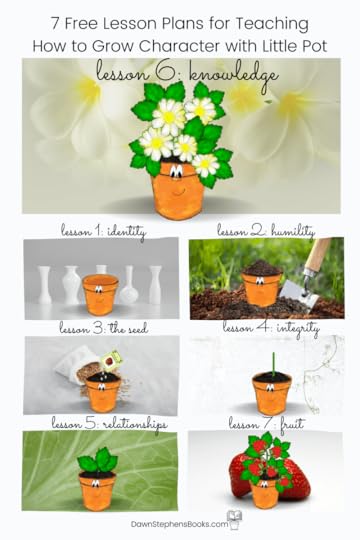 The 7 lessons within education for character.Review the previous lessons covered in our Education for Character.
The 7 lessons within education for character.Review the previous lessons covered in our Education for Character.Review the information in the first, second, third, fourth, and fifth lessons. Before a flower blooms, many steps take place. We began with who we are, a vessel created by the potter. It is important to know our identity. Then, we filled ourselves with humus, the Latin word for humility. Next, we planted the right seed. Fourthly, a strong and upright stem grew, representing our integrity. That stem supports strong healthy relationships. Finally, those relationships lead to new knowledge and information that blooms and will eventually produce the fruit of the Spirit.
Lesson Plan 6: Bloom KnowledgeIn this lesson, Students will learn the parts of a flower and gain an understanding of pollination. Likewise, they will connect pollination and how our minds bloom with new knowledge.
Listen to wisdom. Try with all your heart to gain understanding. Cry out for wisdom. Beg for understanding. Search for it as you would for silver. Hunt for it like hidden treasure. Then you will understand what it means to respect the Lord. Then you will begin to know God. Only the Lord gives wisdom. Knowledge and understanding come from him. -Proverbs 2:2-6What does a flower do?Under a flower are hard petal-like structures called sepals. The sepal protects the flower. Inside a flower are long tubes with a fuzzy ball on each end. This is called a stamen. The tube part of the stamen is called an anther, and the fuzzy end is called the filament. The stamen makes pollen. Therefore, flowers create a sugary liquid called nectar that pollinators (bees, butterflies, and other insects) love to eat.
The pretty colors and wonderful scent of the petals attract the pollinators. When the pollinators come to eat the nectar, pollen gets stuck on their bodies, and then they carry that pollen to the carpel (or pistil) of the flower. Next, the pollen gets inside the carpel (or pistil).
The top of the carpel (or pistil) is called a stigma. It is tacky, causing the pollen to stick. The pollen then travels down inside the carpel (or pistil) in the part known as the style. When that happens, a seed forms in the bottom of the carpel (or pistil) in the part known as the ovary. Some flowers have only one carpel. Some have hundreds. The following video explains the process well.
The complete curriculum comes with worksheets where students can show their understanding of the functions of the flower.
Buy the complete curriculum.Connecting Pollination to Growing the Fruit of the SpiritWe have learned that pollination is when pollen is transferred from the stamen to the stigma to reproduce. We now see that a flower’s job is to attract pollinators and form seeds inside new fruit. When God grows the fruit of the Spirit through us, He essentially does the same thing. The knowledge we bloom through our humility, God’s Word, integrity, and relationships will transform into love, joy, peace, patience, kindness, goodness, faithfulness, and self-control. The following chart provides a comparison between pollination and knowledge.
PollinationKnowledgeThe flower attracts bees, butterflies, and other insects.When we have knowledge on a topic, we attract others.Insects search for nectar in the flowers.Just as Proverbs 2:2-6 tellus, we are to search for knowledge.Pollen lands on the insects as they come and go. It gets left wherever the insects go.Knowledge lands on us as we humbly read God’s Word, have integrity, and commune with others in relationships. We can leave that same knowledge wherever we go.The Stamen produces the pollen but needs the other parts of the flower to make seeds and reproduce.We are not able to gain new knowledge on our own.Flowers share their pollen with other flowers.It is important to share your knowledge with others.Pollen propagates the development of the seed inside.Our knowledge should propagate the seed of God’s WordFlowers pollinate during different seasons and at different rates and times.We each gain new knowledge in different seasons and at different rates and times.Conclusion
In conclusion, have students share the knowledge and information they have learned from others. To remind them they are always blooming knowledge, they can illustrate what they’ve learned on a flower picture.
In the next lesson, we will go more in-depth and learn about the fruit that the flower helped produce. The fruit has important functions to protect and spread the plant’s seed. However, If you can’t wait, purchase the complete curriculum here for just $10.25.
Buy the complete curriculum.In the meantime, I hope you will sign up for the Fruitful Friday emails and Little Pot’s seven fruit-bearing steps below.
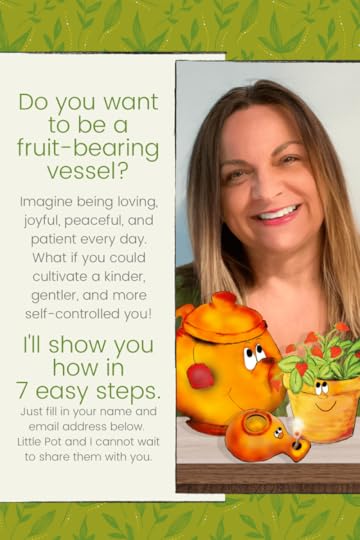 Learn how the potter grows the fruit of the Spirit through you.
Learn how the potter grows the fruit of the Spirit through you. 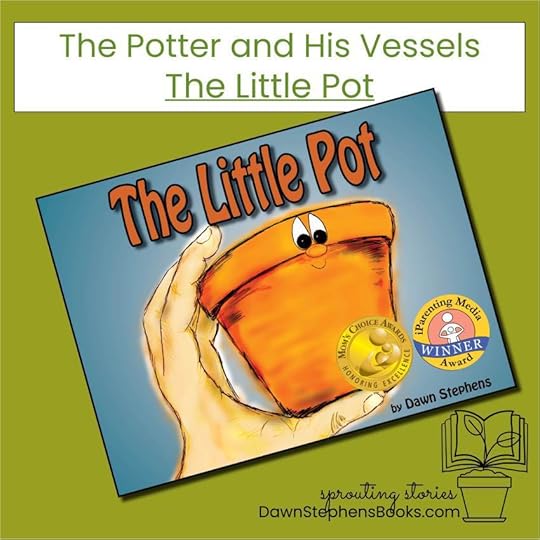 1. The Little Pot Picture Book Add to cart
1. The Little Pot Picture Book Add to cart 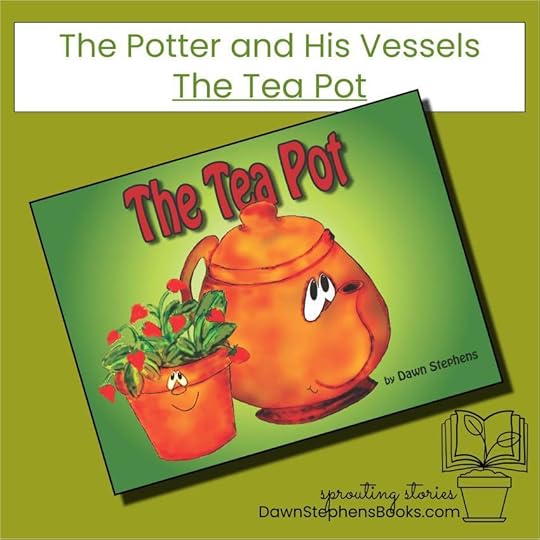 2. The Tea Pot Picture Book Add to cart
2. The Tea Pot Picture Book Add to cart 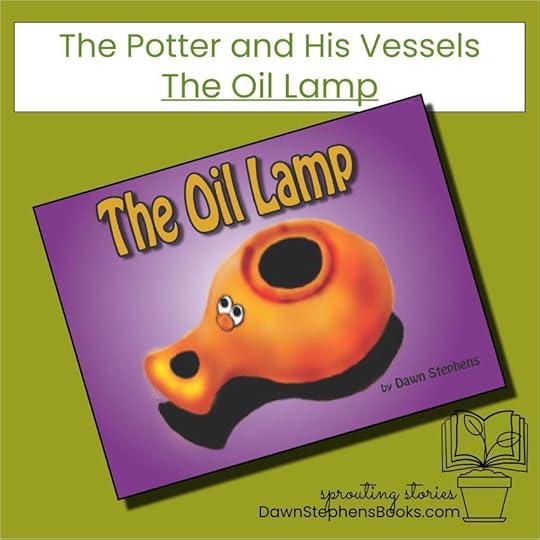 3. The Oil Lamp Picture Book Add to cart
3. The Oil Lamp Picture Book Add to cart  4. Burnout Fit In Picture Book Add to cart
4. Burnout Fit In Picture Book Add to cart Disclosure: The links above are affiliate links, meaning, at no additional cost to you, I will earn a commission if you click through and make a purchase.
The post 7 Free Lessons in the Education for Character that Blooms Knowledge. appeared first on Learn a lot from The Little Pot.
June 12, 2023
Teaching about character traits with Little Pot – #5 Fostering Healthy Relationships
Teaching about character traits can be tricky. However, Little Pot, the main character in the lesson and a fruit-bearing vessel created by the potter brings clarity and simplicity to the task. Additionally, in these seven FREE lessons, children learn the fruit-bearing cycle and how to produce love, joy, peace, patience, kindness, goodness, faithfulness, gentleness, and self-control. Likewise, the activities perfectly blend fun and learning with understanding. The fifth lesson in this series fosters healthy relationships. So, let’s dive into Little Pot’s fifth lesson and continue teaching about character traits.
Read more: Teaching about character traits with Little Pot – #5 Fostering Healthy RelationshipsWhy you should use Little Pot when teaching about character traits.First, let’s discuss why Little Pot is the perfect tool for teaching character traits. The seven lessons illustrate complex concepts in a way that’s easy to understand. Little Pot’s fruit-growing cycle can teach character traits such as identity, humility, integrity, relationships, and knowledge. Moreover, Little Pot is a tangible reminder of the creator’s love and care for us. It symbolizes how God nurtures us, wants a relationship with us, and helps us grow into the people He wants us to be.
You’re not just teaching good behavior when you use Little Pot. You’re helping others understand that character is not fixed or innate but something God cultivates and develops over time. Using Little Pot as a teaching tool develops the skills and attitudes needed to become the vessels God designed us to be. Each week, we will discuss one of the following lesson plans.
Lesson Plan 1: IdentityLesson Plan 2: Humility and How to Contain ItLesson Plan 3: Planting the Right SeedsLesson Plan 4: Strong and Upright IntegrityLesson Plan 5: Fostering Healthy RelationshipsLesson Plan 6: Blooming KnowledgeLesson Plan 7: Producing Fruit of the SpiritIf you prefer to buy the entire curriculum with all the lesson plans, worksheets, posters, and activities included. Click below.
Buy the complete curriculum.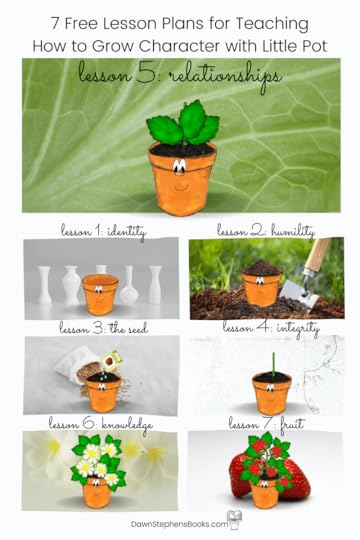 Teaching Character Traits. Lesson 5 – Relationships.Review the previous lessons for teaching character traits.
Teaching Character Traits. Lesson 5 – Relationships.Review the previous lessons for teaching character traits.Review the information in the first, second, third, and fourth lessons about identity, humility, the seed, and integrity. Remind them that their strong, upright integrity is grown from God’s Word. It was planted in a humble heart and can support strong healthy relationships. Those relationships are like the leaves of a plant.
Lesson Plan 5: Fostering Healthy RelationshipsStudents will explain the function of a leaf as providing the plant with food. They will be able to define photosynthesis. Likewise, they will discover and learn the importance of having good friends and relationships that show them the light of Christ.
Learning about photosynthesisLight is necessary for a plant to grow and bear fruit. It is the sunlight that allows the leaf to combine air and water and make food for the plant. Combining light, water, and air is called photosynthesis. Photo means light, and synthesis means to combine.
Here is how it works:Water (H2O) is absorbed from the soil through the roots.Air is made up of carbon dioxide (CO2) and oxygen. (O2)People breathe in oxygen and breathe out carbon dioxide.Plants breathe in carbon dioxide and breathe out oxygen.Plants provide the oxygen that we need to breathe.Light provides the energy the leaf needs to turn the carbon dioxide and water into glucose which is food for plants.It is the job of the leaf to capture the sunlight so that it can turn carbon dioxide and water into food and oxygen.The complete curriculum comes with worksheets where students can show their understanding of photosynthesis.
Buy the complete curriculum.Bible verses for teaching about character traitsWhoever spends time with wise people will become wise. But whoever makes friends with fools will suffer.Proverbs 13:20Let us think about each other and help each other show love and do good deeds. You should not stay away from the church meetings, as some are doing. But you should meet together and encourage each other. Do this even more as you see the Day coming.Hebrews 10:24-25Connecting the Leaf to Relationships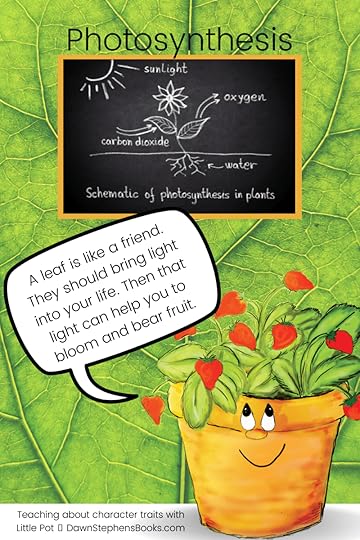 Compare the leaf to relationships when teaching about character traits with Little Pot.
Compare the leaf to relationships when teaching about character traits with Little Pot.Now that we understand the job of a leaf. Let us connect that to the job of a friend or really anyone that we have a relationship with. The leaf helps the plant to be fruitful because it feeds the plant by making food from light. We need people who will use the light of Jesus to feed our souls. A good friend will talk to us about Jesus. When they share about Jesus, they are bringing the light of Jesus to us, and that positive energy gives us a type of nourishment that will help us to be more loving, joyful, patient, kind, etc. Without the leaves, the plant cannot grow and bear fruit. Likewise, without strong Godly relationships, we cannot grow and bear the fruit of the Spirit.
Additionally, If a leaf is no longer green and is wilted, it is not absorbing light and producing food for the plant. It can even pull the nutrients away from the part of the plant that is growing. When this happens to a leaf, it usually falls off the plant. Sometimes it will need to be cut off the plant. In the same way, we can have a friend not providing us with the light of Jesus. It may mean that we need to remove them from parts of our life so we can grow more fruit. That is why we must choose friends and relationships that absorb the light of Jesus. We must ensure we are the healthy leaf in someone else’s life. We need to absorb the light of Christ and give it to others too.
ConclusionIn conclusion, have the students draw leaves and write the name of one person on each. The person should be someone that they have a relationship with. (A friend, a parent, a teacher, a coach, etc.) As a class, create a large picture on the board of a Little Pot with a stem. As the students write a name on each leaf, tape it along the stem. Then share examples of how these people share the light of Jesus with them.
In the next lesson, we will discuss what grows from healthy relationships. The leaves allow something very special to form at the top of the plant. However, If you can’t wait, purchase the complete curriculum here for just $10.25.
Buy the complete curriculum.In the meantime, I hope you will sign up for the Fruitful Friday emails and Little Pot’s seven fruit-bearing steps below.
 Learn how the potter grows the fruit of the Spirit through you.
Learn how the potter grows the fruit of the Spirit through you.  1. The Little Pot Picture Book Add to cart
1. The Little Pot Picture Book Add to cart  2. The Tea Pot Picture Book Add to cart
2. The Tea Pot Picture Book Add to cart  3. The Oil Lamp Picture Book Add to cart
3. The Oil Lamp Picture Book Add to cart  4. Burnout Fit In Picture Book Add to cart
4. Burnout Fit In Picture Book Add to cart Disclosure: The links above are affiliate links, meaning, at no additional cost to you, I will earn a commission if you click through and make a purchase.
The post Teaching about character traits with Little Pot – #5 Fostering Healthy Relationships appeared first on Creative Teaching Resources and Inspirational Children's Books from Dawn Stephens books.
June 5, 2023
How to teach character traits with Little Pot – #4 Integrity
Knowing how to teach character traits can be tricky. However, Little Pot, the main character in the lesson and a fruit-bearing vessel created by the potter brings clarity and simplicity to the task. Additionally, in these seven FREE lessons, children learn the fruit-bearing cycle and how to produce love, joy, peace, patience, kindness, goodness, faithfulness, gentleness, and self-control. Likewise, the activities perfectly blend fun and learning with understanding. The fourth lesson in this series, A Strong and Upright Stem, is all about integrity. So, let’s dive into Little Pot’s fourth lesson and discover how to teach character traits!
Read more: How to teach character traits with Little Pot – #4 IntegrityWhy you should use Little Pot when teaching character traits.First, let’s discuss why Little Pot is the perfect tool for teaching character traits. The seven lessons illustrate complex concepts in a way that’s easy to understand. Little Pot’s fruit-growing cycle can teach character traits such as identity, humility, integrity, relationships, and knowledge. Moreover, Little Pot is a tangible reminder of the creator’s love and care for us. It symbolizes how God nurtures us, wants a relationship with us, and helps us grow into the people He wants us to be.
You’re not just teaching good behavior when you use Little Pot. You’re helping others understand that character is not fixed or innate but something God cultivates and develops over time. Using Little Pot as a teaching tool develops the skills and attitudes needed to become the vessels God designed us to be. Each week, we will discuss one of the following lesson plans.
Lesson Plan 1: IdentityLesson Plan 2: Humility and How to Contain ItLesson Plan 3: Planting the Right SeedsLesson Plan 4: Strong and Upright IntegrityLesson Plan 5: Fostering Healthy RelationshipsLesson Plan 6: Blooming KnowledgeLesson Plan 7: Producing Fruit of the SpiritIf you prefer to buy the entire curriculum with all the lesson plans, worksheets, posters, and activities included. Click below.
Buy the complete curriculum.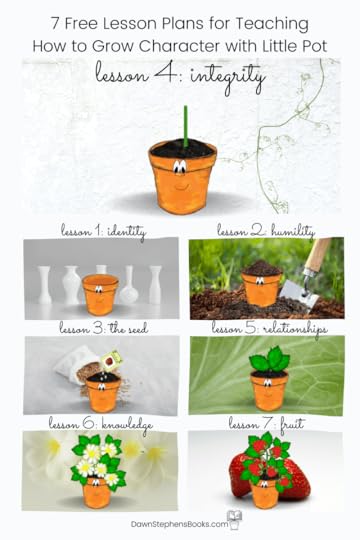 Teaching Character Traits. Lesson 3 The Seed.Lesson Plan 4: Strong and Upright Integrity
Teaching Character Traits. Lesson 3 The Seed.Lesson Plan 4: Strong and Upright IntegrityThis series’s fourth lesson plan is about integrity. This lesson plan aims to define integrity and discover why it is important to be strong and upright. Students will explain the function of a stem as supporting the plant and transporting substances to all parts of the plant. Likewise, they will connect how their integrity supports their character and transports the seed, God’s Word, to others.
The set of Lesson 4Study plants or pictures of plants. Look closely at the stem of the plant. Then, ask students to tell you what they think the job of the stem is. Discuss that they grow straight and upright. Then read the following Bible verses looking for a word that describes us when we walk straight (not crooked) and upright.
Bible verses for how to teach character traitsWhoever walks in integrity walks straight, but he who makes his ways crooked will be found out. Proverbs 10:9The integrity of the upright guides them, but the crookedness of the treacherous destroys them. Proverbs 11:3 Better is a poor person who walks in his integrity than one who is crooked in speech and is a fool. Proverbs 19:1Better is a poor man who walks in his integrity than a rich man who is crooked in his ways.Proverbs 28:6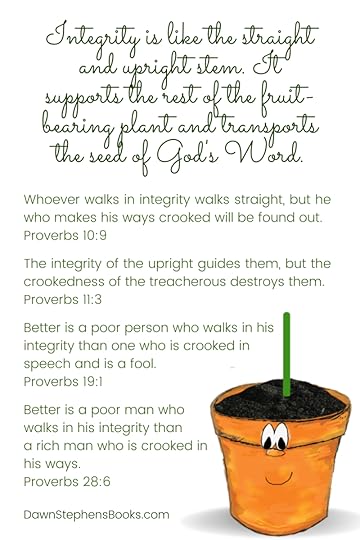 Bible verse about integrity.
Bible verse about integrity.That word is integrity. Dig deeper into what it means to “walk” and “talk” straight and upright. Younger children will look for a literal meaning, like walking in a straight line. Help them to understand that it also means to be honest and trustworthy.
Discuss with them when someone has lied to you; it makes it hard to trust them. Likewise, if they have been mean to you, you may not want to play with them or hear what they say. Then explain that we will see how the stem of the plant can be like a person with integrity.
Review the previous lessons for teaching character traits.Next, explain the parable’s meaning as you review the previous lessons.
Review the information in the first, second, and third lessons about identity, humility, and the seed. Realizing that strong, upright integrity grows from God’s Word planted in a humble heart.
ProceduresA. Celery ExperimentExplain that celery acts like the stem of a plant. Using the food coloring, jars, and celery, complete the experiment. Record daily observations in an experiment journal by drawing, coloring, and writing.
Step 1: First, fill three jars half full of water. Add a few drops of food coloring to each jar. Choose a different color for each jar. Darker colors work best.Step 2: Then, gather three stalks of cleaned celery and cut about an inch off the bottom, leaving the leaves on the top.Step 3: Thirdly, stand one stalk in each jar.Step 4: Let the celery sit for a few days and record on the following sheet your observations from each day.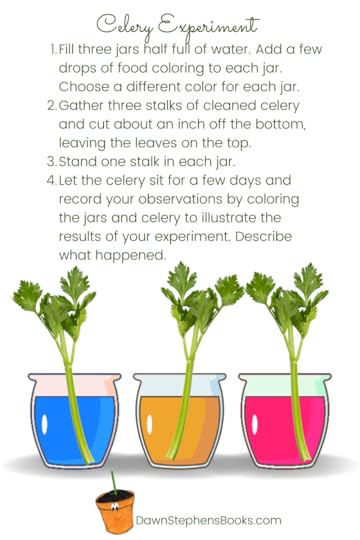 Complete this experiment to discover what a stem does.
Complete this experiment to discover what a stem does.The complete curriculum includes a worksheet to copy and record your observations. Click here to purchase the booklet.
Buy the complete curriculum.B. Connecting the Stem to Having Good Integrity.Create a Venn Diagram like the one pictured below. Compare the functions of a stem to the function of integrity. Both transport substances and are straight, upright, and supportive.
A StemIntegritySupports plants and hold leaves, flowers, and fruits above the ground.Give support to others and hold them up when they feel bad.Keep the leaves in the light and enable flowers and fruit to grow.Keep others in the light and enables strong relationships and knowledge to growTransport fluids and nutrients between the roots and leaves.You are trustworthy, and the information that you share helps others grow. comparing a stem to our integrity.Conclusion
comparing a stem to our integrity.ConclusionIn conclusion, it is good to note that no one ever notices the stem. Consequently, we do not look at a plant and say, “Wow, that’s a nice stem.” Instead, we notice the leaves, the flower, and the fruit. The same is true with integrity. No one really notices your integrity. They will notice, the things your integrity supports and that you are trustworthy and honest. What are some things that you do that show good integrity?
Additionally, if a stem has a small crack in it, what could happen to the plant? Likewise, how would just a small crack in our integrity damage us or others?
In the next lesson, we will discuss what grows from good integrity. The straight and upright stem will sprout leaves, and the leaves represent the next idea of how to teach character traits. However, If you can’t wait, purchase the complete curriculum here for just $10.25.
Buy the complete curriculum.In the meantime, I hope you will sign up for the Fruitful Friday emails and Little Pot’s seven fruit-bearing steps below.
 Learn how the potter grows the fruit of the Spirit through you.
Learn how the potter grows the fruit of the Spirit through you.  1. The Little Pot Picture Book Add to cart
1. The Little Pot Picture Book Add to cart  2. The Tea Pot Picture Book Add to cart
2. The Tea Pot Picture Book Add to cart  3. The Oil Lamp Picture Book Add to cart
3. The Oil Lamp Picture Book Add to cart  4. Burnout Fit In Picture Book Add to cart
4. Burnout Fit In Picture Book Add to cart Disclosure: The links above are affiliate links, meaning, at no additional cost to you, I will earn a commission if you click through and make a purchase.
The post How to teach character traits with Little Pot – #4 Integrity appeared first on Creative Teaching Resources and Inspirational Children's Books from Dawn Stephens books.
May 29, 2023
Little Pot’s 7 Free Lessons for Teaching Character Traits – #3 The Seed
Teaching character traits with Little Pot, the main character in the lesson, and a fruit-bearing vessel created by the potter can be an exciting adventure. Through the journey, children learn the fruit-bearing cycle and how to produce love, joy, peace, patience, kindness, goodness, faithfulness, gentleness, and self-control. These lessons perfectly blend fun and learning with engaging activities. The third lesson in this series, The Seed, is all about planting the correct information so good character can grow. So, let’s dive into Little Pot’s third lesson and discover the significance of The Seed!
Read more: Little Pot’s 7 Free Lessons for Teaching Character Traits – #3 The SeedWhy you should use Little Pot when teaching character traits.First, let’s discuss why Little Pot is the perfect tool for teaching character traits. The seven lessons illustrate complex concepts in a way that’s easy to understand. Little Pot’s fruit-growing cycle can teach character traits such as identity, humility, integrity, relationships, and knowledge. Moreover, Little Pot is a tangible reminder of the creator’s love and care for us. It symbolizes how God nurtures us, wants a relationship with us, and helps us grow into the people He wants us to be.
You’re not just teaching good behavior when you use Little Pot. You’re helping others understand that character is not fixed or innate but something God cultivates and develops over time. Using Little Pot as a teaching tool develops the skills and attitudes needed to become the vessels God designed us to be. Each week, we will discuss one of the following lesson plans.
Lesson Plan 1: IdentityLesson Plan 2: Humility and How to Contain ItLesson Plan 3: Planting the Right SeedsLesson Plan 4: Strong and Upright IntegrityLesson Plan 5: Fostering Healthy RelationshipsLesson Plan 6: Blooming KnowledgeLesson Plan 7: Producing Fruit of the SpiritIf you prefer to buy the entire curriculum with all the lesson plans, worksheets, posters, and activities included. Click below.
Buy the complete curriculum. Teaching Character Traits. Lesson 3 The Seed.Lesson Plan 3: Planting the Right Seeds
Teaching Character Traits. Lesson 3 The Seed.Lesson Plan 3: Planting the Right SeedsThis series’s third lesson plan is about planting the right seeds. This lesson plan aims to help students understand the parable of the sower (Luke 8 and Matthew 13). Within the parable, Jesus referred to God’s Word as the seed. Therefore, God’s Word (the Bible) should be planted in them and take root in their life.
The set of Lesson 3Begin by reading the Parable of the Sower.
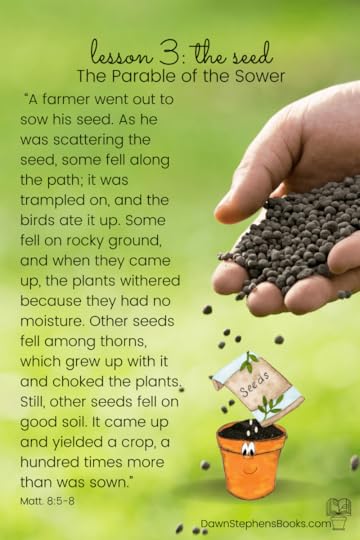 The parable of the sower explains the seed lesson in Little Pot’s way of teaching character traits.A farmer went out to sow his seed. As he was scattering the seed, some fell along the path; it was trampled on, and the birds ate it up. Some fell on rocky ground, and when they came up, the plants withered because they had no moisture. Other seeds fell among thorns, which grew with it and choked the plants. Still, other seeds fell on good soil. It yielded a crop a hundred times more than was sown.”Review the previous lessons for teaching character traits.
The parable of the sower explains the seed lesson in Little Pot’s way of teaching character traits.A farmer went out to sow his seed. As he was scattering the seed, some fell along the path; it was trampled on, and the birds ate it up. Some fell on rocky ground, and when they came up, the plants withered because they had no moisture. Other seeds fell among thorns, which grew with it and choked the plants. Still, other seeds fell on good soil. It yielded a crop a hundred times more than was sown.”Review the previous lessons for teaching character traits.Next, explain the parable’s meaning as you review the previous lessons.
Review the information in the first and second lessons about identity and humility. Discuss with the students that the location of the seed was important for its growth. Good soil is humus, and it was in that dirt that the seeds could thrive. Therefore, when growing good character, soil quality and humility are important.
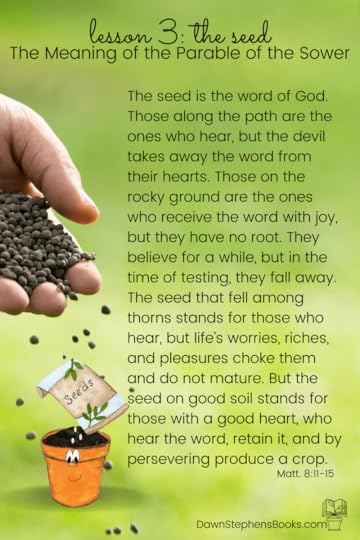 The seed is God’s Word.
The seed is God’s Word.The seed is the word of God. Those along the path are the ones who hear, but the devil takes away the word from their hearts. Those on the rocky ground are the ones who receive the word with joy, but they have no root. They believe for a while, but in the time of testing, they fall away. The seed that fell among thorns stands for those who hear, but life’s worries, riches, and pleasures choke them and do not mature. But the seed on good soil stands for those with a good heart, who hear the word, retain it, and by persevering produce a crop.
ProceduresA. Sequence and retell the parableDraw a picture for each section of the parable. One picture should contain the birds. The next rocks, and the third thorns. The last picture should show the seeds sprouting in good soil. With the pictures mixed up, have students sequence the images and retell the parable to friends.
Copy each picture and challenge students to write their text in a self-made booklet. These images are included in the curriculum if you would rather purchase them over creating your images.
Buy the complete curriculum.B. The quality of the seed is also important.Likewise, the seed’s quality will determine the fruit’s quality. The world has a lot of information to give us. Knowing we are created by the potter and containing a humble heart is insufficient. It is easy to plant the wrong information. For example, if we plant untruths, we will bear bad fruit. You can then ask your students to reflect on where truth comes from. In Galatians, just before Paul speaks of the fruit of the Spirit, he warns of false teachers. It is important students know the information they hear is Truth.
Using paper seeds, write various biblical truths and Bible verse references on them. Place them inside a seed packet. Then, students can pull out different seeds and “plant” them in their hearts. A great resource is the Seeds Family Worship. Check out their YouTube videos.
ConclusionReview with students once again what “good” soil is and that our hearts are to be humble. Planting the seeds of God’s Word in our hearts should be ongoing. Continue to use the seed pouches and write new Bible verse references throughout the year.
In the next lesson, we will discuss what grows from the seed. The straight and upright stem will help us understand integrity. However, If you can’t wait, purchase the complete curriculum here for just $10.25.
Buy the complete curriculum.In the meantime, I hope you will sign up for the Fruitful Friday emails and Little Pot’s seven fruit-bearing steps below.
 Learn how the potter grows the fruit of the Spirit through you.
Learn how the potter grows the fruit of the Spirit through you.  1. The Little Pot Picture Book Add to cart
1. The Little Pot Picture Book Add to cart  2. The Tea Pot Picture Book Add to cart
2. The Tea Pot Picture Book Add to cart  3. The Oil Lamp Picture Book Add to cart
3. The Oil Lamp Picture Book Add to cart  4. Burnout Fit In Picture Book Add to cart
4. Burnout Fit In Picture Book Add to cart Disclosure: The links above are affiliate links, meaning, at no additional cost to you, I will earn a commission if you click through and make a purchase.
The post Little Pot’s 7 Free Lessons for Teaching Character Traits – #3 The Seed appeared first on Creative Teaching Resources and Inspirational Children's Books from Dawn Stephens books.
May 22, 2023
Scripture for Humility and 7 Lessons in Character With Little Pot
If you follow the scripture for humility, you can cultivate good character. Humility is a necessary ingredient to grow good character. Just ask Little Pot, a vessel created by the potter to grow fruit. It provides an excellent opportunity for teaching children about love, joy, peace, patience, kindness, goodness, faithfulness, gentleness, and self-control. These free lesson plans use Little Pot’s fruit-growing cycle as the key to character education. Whether teaching in a classroom, homeschooling, or working with a church group, the lesson plans can adapt to your students. By the end of these lessons, your students will have learned the science behind Little Pot growing fruit and discover how their creator grows character traits in them. If you missed lesson one, you can get it here. So, let’s continue this journey of growing character with Little Pot!
Why use Little Pot for character development?Little Pot can help illustrate complex concepts in a way that’s easy for children to understand. The fruit-growing cycle can teach what is required for character traits, including identity, humility, integrity, relationships, and knowledge. Moreover, Little Pot is a tangible reminder of the creator’s love and care for us. It symbolizes how God made us, nurtures us, and helps us grow into the people He wants us to be.
When you use Little Pot for character development, you’re not just teaching your students about good behavior. You’re helping them better understand who they are and who they want to be. You’re helping them understand that character is not fixed or innate but something God cultivates and develops over time. Using Little Pot as a teaching tool, you can help your students develop the skills and attitudes they need to become the vessel God created them to be. Each week, we will discuss one of the following lesson plans. This week will discuss scriptures for humility, what humility is, and why we need it.
Lesson Plan 1: IdentityLesson Plan 2: Humility and How to Contain ItLesson Plan 3: Planting the Right SeedsLesson Plan 4: Strong and Upright IntegrityLesson Plan 5: Fostering Healthy RelationshipsLesson Plan 6: Blooming KnowledgeLesson Plan 7: Producing Fruit of the Spirit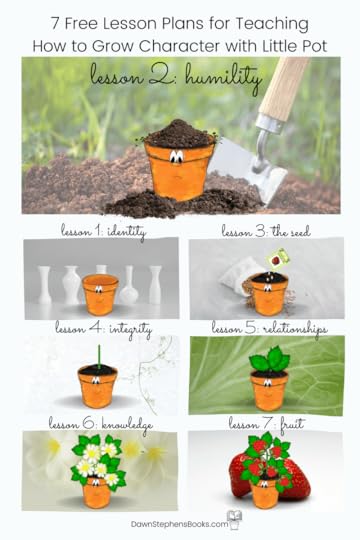 The second lesson in teaching character with Little Pot includes scripture for humility.Scripture for humilityPhilippians 2:3-4When you do things, do not let selfishness or pride be your guide. Be humble and give more honor to others than to yourselves. Do not be interested only in your own life but be interested in the lives of others.Colossians 3:12Therefore, as God’s chosen people, holy and dearly loved, clothe yourselves with compassion, kindness, humility, gentleness and patience.Ephesians 4:2Be completely humble and gentle; be patient, bearing with one another in love.James 4:5But he gives us more grace. That is why Scripture says: “God opposes the proud but shows favor to the humble.”James 4:10Humble yourselves before the Lord, and he will lift you up.1 Peter 5:5In the same way, you who are younger, submit yourselves to your elders. All of you, clothe yourselves with humility toward one another, because, “God opposes the proud but shows favor to the humble.”2 Chronicles 7:14if my people, who are called by my name, will humble themselves and pray and seek my face and turn from their wicked ways, then I will hear from heaven, and I will forgive their sin and will heal their land.Luke 14:11For all those who exalt themselves will be humbled, and those who humble themselves will be exalted.”Micah 6:8He has shown you, O mortal, what is good. And what does the LORD require of you? To act justly and to love mercy and to walk humbly with your God.
The second lesson in teaching character with Little Pot includes scripture for humility.Scripture for humilityPhilippians 2:3-4When you do things, do not let selfishness or pride be your guide. Be humble and give more honor to others than to yourselves. Do not be interested only in your own life but be interested in the lives of others.Colossians 3:12Therefore, as God’s chosen people, holy and dearly loved, clothe yourselves with compassion, kindness, humility, gentleness and patience.Ephesians 4:2Be completely humble and gentle; be patient, bearing with one another in love.James 4:5But he gives us more grace. That is why Scripture says: “God opposes the proud but shows favor to the humble.”James 4:10Humble yourselves before the Lord, and he will lift you up.1 Peter 5:5In the same way, you who are younger, submit yourselves to your elders. All of you, clothe yourselves with humility toward one another, because, “God opposes the proud but shows favor to the humble.”2 Chronicles 7:14if my people, who are called by my name, will humble themselves and pray and seek my face and turn from their wicked ways, then I will hear from heaven, and I will forgive their sin and will heal their land.Luke 14:11For all those who exalt themselves will be humbled, and those who humble themselves will be exalted.”Micah 6:8He has shown you, O mortal, what is good. And what does the LORD require of you? To act justly and to love mercy and to walk humbly with your God. Scripture for humilityUnderstanding the Scripture on humility
Scripture for humilityUnderstanding the Scripture on humilityThe Bible has a lot to say about humility. These are only a few verses within the scriptures. Each time it is mentioned; however, it says that the humble will be blessed or exalted. Obviously, being humble is a desirable trait. God wants us to be humble. Therefore, we need to know what it is and is not.
What is humility?The internet defines humility as “a modest or low view of one’s importance.” The Merriam-webster dictionary says the word is derived from the Latin word humilis, meaning “low.” It also comes from the Latin word humus, meaning dirt and earth. Based on these definitions, you may not want humility. Little Pot was not very excited about having dirt poured into it either. However, throughout this lesson, you’ll see it as a necessary basis to cultivate your character. I love the following quote by Anthony Bloom.
Lesson Plan 2: Humility and How to Contain It“The word ‘humility’ comes from the Latin word ‘humus’ which means fertile ground. Humility is the situation of the earth. The earth is always there, always taken for granted, never remembered, always trodden on by everyone, somewhere we cast and pour out all the refuse, all we don’t need. It’s there, silent and accepting everything and in a miraculous way making out of all the refuse new richness in spite of corruption, transforming corruption itself into a power of life and a new possibility of creativeness, open to the sunshine, open to the rain, ready to receive any seed we sow and capable of bringing thirtyfold, sixtyfold, a hundredfold, out of every seed.”
-Anthony Bloom, Beginning to Pray
Begin by reviewing lesson 1, where you introduced Little Pot. Remind students that Little Pot searched for its purpose and identity. Finally, it knew it would be a fruit pot and grow fruit for the potter. Likewise, they can bear fruit for their creator. The fruit they need to produce is love, joy, peace, patience, kindness, goodness, faithfulness, gentleness, and self-control. This series’s lesson plans will follow Little Pot’s journey in growing fruit. Consequently, the first thing Little Pot needs is dirt.
Not just any dirt will do, however. Humility comes from the word humus, the dark, organic material that forms when plant and animal matter decays on the ground. It sits on top of the soil and is the best dirt for growing things. Plants drop leaves, twigs, and other materials to the ground. When animals defecate waste or die, their remains add to the soil too.
The set of the lessonAfter reminding students of lesson one and Little Pot needing dirt to grow fruit, watch the following video. Discuss what dirt is and what dirt is best for growing things.
ProceduresA. Learn about dirt layers.Create a diagram of the layers in the dirt. Include:
HumusTopsoilSubsoilParent materialBedrockHumus is made of organic matter. Therefore, it contains living material or material that came from living things like manure, leaves, worms, and insects. Topsoil is often rich in humus, minerals, bacteria, and fungi. This is where the roots of plants grow. The subsoil is made of sand, small rocks, and clay. It is poor in humus, but rich in minerals. Next, the parent material is mostly rock. Consequently, there is barely any plant or animal life here. Finally, the bottom layer is the bedrock. This is a solid rock layer.
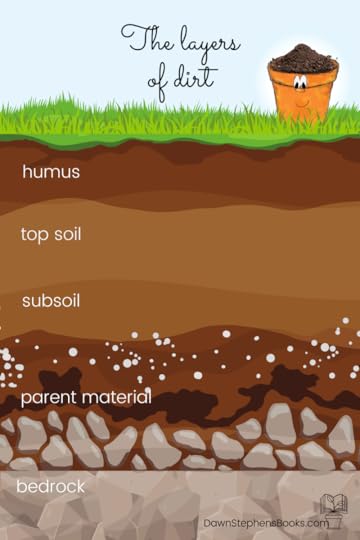 The dirt layers are humus, topsoil, subsoil, parent material, and bedrock.
The dirt layers are humus, topsoil, subsoil, parent material, and bedrock.If you do not want to draw your own dirt layers, you can purchase the full curriculum that includes a worksheet for this activity.
Buy the complete curriculum.B. Learn about the different particles found in dirt.Help students examine the different particles found in dirt. The soil layers contain three different particles: sand and gravel, silt, and clay. Sand is the largest particle found in soil. It does not have any nutrients but helps water to drain. The silt is medium size. It feels powdery and smooth when dry and slippery when wet. It has crucial minerals in it. Clay is the smallest particle in soil. It feels smooth and hard when dry and sticky when wet. It does not allow much air or water to pass through. The best soil contains 20% clay, 40% silt, and 40% sand. This soil is known as loam. You can experiment to see if the soil around your school or house has the right amount of clay, silt, and sand.
Fill a large mason jar halfway with dirt from your yard. Fill the remaining jar with water, leaving about an inch of air at the top. Screw the lid on tight.Shake until all the dirt clumps are broken up. Let the jar sit overnight. The next day you can see the different soil layers in your jar.Draw a picture of the jar and layers, labeling the different sections.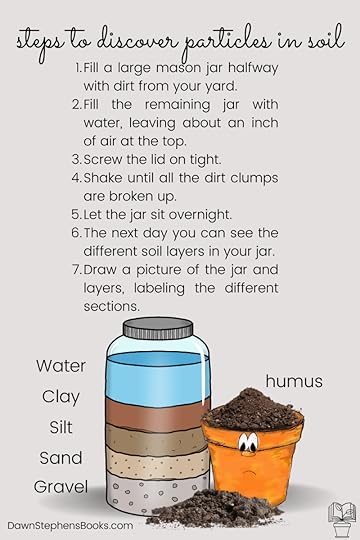 The particles in the soil will separate.Connecting Humus to Scripture for Humility
The particles in the soil will separate.Connecting Humus to Scripture for HumilitySince humus is made from organic matter like manure and dead things, let’s consider how manure and things that have died connect to our humility.
Manure:We often describe the terrible things in our lives as poop (or other words with the same meaning). Does God allow bad things to happen to us? Why? One reason is that it makes us humble. We grow when we experience bad things because we want things to improve. Likewise, we can learn can relate to and help others who experience difficult times.
Dead Things:One of my favorite definitions of humility is “not thinking less of yourself, but thinking of yourself less.” In essence, that means we put God and others before ourselves. The greatest act of humility is what Christ went through to die on the cross for our sins. His death happened so we could live. Likewise, God asks us to die to ourselves so He can live through us. The connection is that death allows new life. Here is more scripture for humility:
John 12:24-26I tell you the truth. A grain of wheat must fall to the ground and die. Then it makes many seeds. But if it never dies, it remains only a single seed. The person who loves his life will give up true life. But the person who hates his life in this world will keep true life forever. Whoever serves me must follow me. Then my servant will be with me everywhere I am. My Father will honor anyone who serves me.1 Corinthians 15:31I die every day. That is true, brothers, just as it is true that I brag about you in Christ Jesus our Lord.A humble person is grounded.The humus is beneath us. When we put the needs of others above ours, we are placing ours below. Talk about ways to be humble and practicle ways to put the needs of others first. You can use Little Pot to illustrate how our creator values and loves us. In conclusion, share about the next lesson in Little Pot’s process of growing fruit. It will be all about integrity.
If you can’t wait, go ahead and purchase the complete curriculum. Additionally, you will receive scripture for humility, worksheets, activities, posters, and more. You can purchase the complete curriculum here for just $10.25.
Buy the complete curriculum.In the meantime, I hope you will sign up for the Fruitful Friday emails and Little Pot’s seven fruit-bearing steps below.
 Learn how the potter grows the fruit of the Spirit through you.
Learn how the potter grows the fruit of the Spirit through you.  1. The Little Pot Picture Book Add to cart
1. The Little Pot Picture Book Add to cart  2. The Tea Pot Picture Book Add to cart
2. The Tea Pot Picture Book Add to cart  3. The Oil Lamp Picture Book Add to cart
3. The Oil Lamp Picture Book Add to cart  4. Burnout Fit In Picture Book Add to cart
4. Burnout Fit In Picture Book Add to cart Disclosure: The links above are affiliate links, meaning, at no additional cost to you, I will earn a commission if you click through and make a purchase.
The post Scripture for Humility and 7 Lessons in Character With Little Pot appeared first on Creative Teaching Resources and Inspirational Children's Books from Dawn Stephens books.
May 15, 2023
7 Free Lesson Plans for Teaching How to Grow Character with Little Pot – 1.
As an educator, teaching character development is just as important as teaching academic subjects. But how do you make character development fun and engaging for your students? Enter Little Pot, a vessel created by the potter to grow fruit. It provides an excellent opportunity for teaching children about love, joy, peace, patience, kindness, goodness, faithfulness, gentleness, and self-control. This and the following six articles will compile seven free lesson plans that use Little Pot’s fruit-growing cycle as the key to character education. Whether you’re teaching in a classroom, homeschooling, or working with a church group, these lesson plans are designed to be adaptable to different age groups and learning styles.
By the end of these lessons, your students will have learned the science behind Little Pot growing fruit and discover how it connects to how their creator grows character traits in them. So, let’s get started on this journey of growing character with Little Pot!
Read more: 7 Free Lesson Plans for Teaching How to Grow Character with Little Pot – 1.Why use Little Pot for character development?Little Pot is a simple yet powerful tool that can help you teach character development to your students. It’s an object lesson that allows you to illustrate complex concepts in a way that’s easy for children to understand. Little Pot’s fruit-growing cycle can be used to teach what is required for character traits, including identity, humility, integrity, relationships, and knowledge. Moreover, Little Pot is a tangible reminder of the creator’s love and care for us. It symbolizes how God nurtures us and helps us grow into the people He wants us to be.
When you use Little Pot for character development, you’re not just teaching your students about good behavior. You’re helping them better understand who they are and who they want to be. You’re helping them know that character is not fixed or innate but something God cultivates and develops over time. Using Little Pot as a teaching tool, you can help your students develop the skills and attitudes they need to become the vessel God created them to be. Each week, we will discuss one of the following lesson plans.
Lesson Plan 1: Identity and Knowing Who You AreLesson Plan 2: Humility and How to Contain ItLesson Plan 3: Planting the Right SeedsLesson Plan 4: Strong and Upright IntegrityLesson Plan 5: Fostering Healthy RelationshipsLesson Plan 6: Blooming KnowledgeLesson Plan 7: Producing Fruit of the Spirit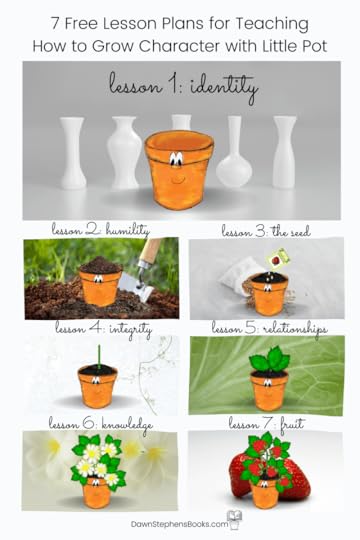 7 Free Lesson Plans for teaching character education with Little Pot1. Free lesson plans for teaching identity – knowing who you are
7 Free Lesson Plans for teaching character education with Little Pot1. Free lesson plans for teaching identity – knowing who you areThis series’s first free lesson plan concerns identity and understanding who you are and “whose” you are. Let’s begin with identifying that you are a person deeply loved.
Why begin with identity?Throughout the New Testament in Galatians, Ephesians, Philippians, and all of Paul’s letters to the church, he reminds them that their identity is in Christ. They confused the gospel message that Christ chose them, died to save them, and brought them into God’s family with the idea that they must do things to earn His favor and love. Likewise, we embrace religion and strive to please a god whose love is conditional. This leads us to a work-based theology; therefore, we believe character is derived through our behaviors alone.
Instead, knowing that God chooses us and loves us so much that He died to save us causes us to respond to others differently. Research shows that the effects of feeling loved are evident in our brains, bodies, and behaviors. Behaviors exhibiting bad character are often demonstrated in children who feel unloved. No amount of character education can combat what happens in the heart of an unloved child.
Gender Identity affects Character Education.Gender identity has become a fluid concept. In society’s attempt at giving children choices, they now can question their gender and whether their creator made a mistake. Today, gender identity is defined as something different than the sex assigned at birth by physical characteristics. Even though most children will label themselves as a boy or girl before their third birthday, the number of adults identifying as different is snowballing. The world says that your identity exists in your mind. You can choose it apart from your creator. Consequently, knowing who you are has become entangled with your character and behaviors.
If you don’t accept that your identity rests in your creator, you are probably searching for it through a career, position, or relationship. We often identify ourselves through the things we hold. Let’s consider Little Pot’s journey.
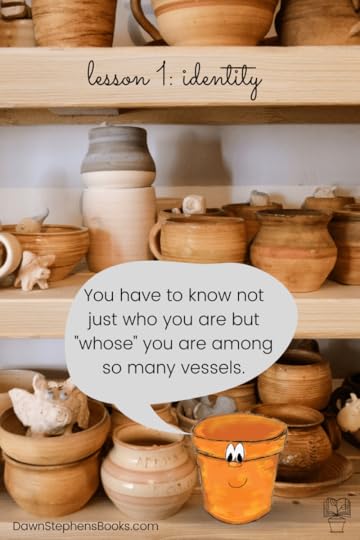 Your identity is not just in who you are but “whose” you are.Little Pot’s identity
Your identity is not just in who you are but “whose” you are.Little Pot’s identityIn the story of Little Pot, the vessel identifies as a paper pot, a coin pot, a dirt pot, and a flower pot. Before the potter names it His fruit pot, Little Pot seeks and changes its identity based on what it holds. Likewise, we believe the things in life we hold define us. And, if what we have does not fit the identity we seek, we are told that we can change who and what we are. On the surface, this concept allows us to encourage children and appear tolerant of their individual choices. However, when taken to the extreme, there are no absolutes presented.
Even though Little Pot identifies itself as different pots throughout the story, it does not question who made it and how it was made. In the second book, the potter creates a teapot. Little Pot watches and compares itself to the new vessel. It wonders if being a teapot is better than being a fruit pot. However, it never believes that the potter made it incorrectly. The potter’s design for each vessel is absolute. The potter creates the vessels and has a purpose for each. To question the Potter’s decisions is to question God’s authority.
Therefore, this lesson aims to help your students understand that they are unique and valuable individuals loved and accepted by their creator. God did not make a mistake in how He created them. If you’re able, share the following Bible verse with them.
Bible verses for identityBut Lord, you are our father.
We are like clay, and you are the potter. Your hands made us all.
Isaiah 64:8
The clay does not ask the potter, ‘What are you doing?’ The thing that is made doesn’t say to its maker, ‘You have no hands.’
Isaiah 45:9b
A potter has the right to do whatever he wants with his clay. He can make something from the same lump for a special occasion or everyday use.
Romans 9:21
We have this treasure from God. But we are only like clay jars that hold the treasure. This shows that this extraordinary power is from God, not from us
2 Corinthians 4:7
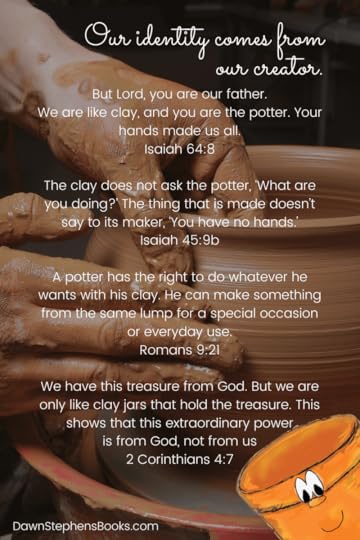 Bible verses to teach identity.The set of the lesson
Bible verses to teach identity.The set of the lessonTo start the lesson, you can ask your students to introduce themselves and share something that makes them unique. Ask them what they want to be. Most likely, they will respond with a job they want to have one day. Ask them if their job should define who they are. Then discuss with them what makes us who we are. Read the story of The Little Pot and talk about what the Little Pot wanted to be. Point out that Little Pot believed it was something different based on what it held. Then point out that the potter was making the choices by giving and taking things away from the vessel. In the end, the potter is growing fruit through the pot. Likewise, our creator wants to produce fruit through us. The fruit we grow is love, joy, peace, patience, kindness, goodness, faithfulness, gentleness, and self-control. (Galatians 5:22-23)
1. The Little Pot Picture Book $17.95 Add to cartTell the students that today we will create a little pot too.
Procedures for making a little potGive each student a ball of Crayola Clay and two googly eyes.
Roll your clay into a ball between your hands.Stick your thumb into the ball. Pinch and turn the edges.Add the googly eyes by pushing them into the wet clay. You can also add a small nose with a tiny ball of clay. Use your thumbnail to make a smile. Set the pots in a safe place to dry overnight.Even though each student follows the same steps, they will see that their creation differs from everyone else’s. You can then explain how we are all created differently. Even if you gave everyone a second ball of clay, the next one they made would look different from the first. Each creation has a unique shape and size. Explain that you will identify the clay pots by the name of the child who made them. Likewise, our identity should be in who created us too. Just as their creations carry their thumbprint and marks from their hands, we are made in God’s image.
For a moment, pretend their clay creations came to life. How would they feel if their vessel did not like how it was made? It would be silly for the clay to question the potter and to think it could remake itself better. As the artist, you would want your creation to appreciate how you designed it.
Next, help each child understand a perfect potter molded and shaped each person.
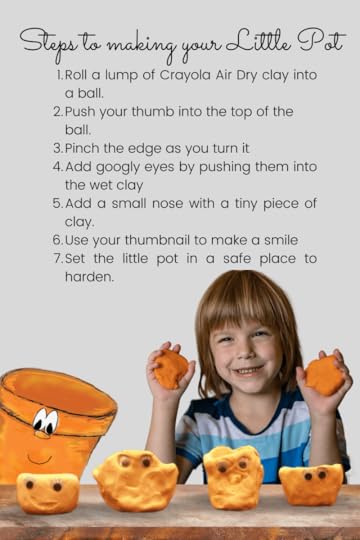 Steps to making your Little PotMore free lesson plans for teaching character
Steps to making your Little PotMore free lesson plans for teaching characterFinally, you can talk about how our identity is not based on our looks, achievements, or accomplishments but on who made us. You can use Little Pot to illustrate how our creator values and loves us. In conclusion, share with them that the next lessons follow Little Pot’s process of growing fruit. That cycle will show us how to have good character and produce the fruit of love, joy, peace, patience, kindness, goodness, faithfulness, gentleness, and self-control.
Next week, we will cover the second of our free lesson plans teaching about humility.
In the next few weeks, we will give you more free lesson plans teaching character education. The complete curriculum includes worksheets, activities, posters, and more. You can purchase the complete curriculum here for just $10.25.
Buy the complete curriculum.Become a fruit-bearing vessel like Little Pot!In the meantime, I hope you will sign up for the Fruitful Friday emails and Little Pot’s seven fruit-bearing steps below.
 Learn how the potter grows the fruit of the Spirit through you.
Learn how the potter grows the fruit of the Spirit through you.You can purchase these books here in our store, and they can be signed by the author specifically for your little graduate. The books are also available on Amazon.
 1. The Little Pot Picture Book Add to cart
1. The Little Pot Picture Book Add to cart  2. The Tea Pot Picture Book Add to cart
2. The Tea Pot Picture Book Add to cart  3. The Oil Lamp Picture Book Add to cart
3. The Oil Lamp Picture Book Add to cart  4. Burnout Fit In Picture Book Add to cart
4. Burnout Fit In Picture Book Add to cart Disclosure: The links above are affiliate links, meaning, at no additional cost to you, I will earn a commission if you click through and make a purchase.
The post 7 Free Lesson Plans for Teaching How to Grow Character with Little Pot – 1. appeared first on Creative Teaching Resources and Inspirational Children's Books from Dawn Stephens books.
May 8, 2023
4 Unique Children’s Stories focused in Scriptures on Potter and Clay
Scriptures on potter and clay exist in Genesis 2, Job 10, Isaiah 29, 45, 64, Jeremiah 18, Lamentations 4, Romans 9, Ephesians 2, 2 Corinthians 4, and 2 Timothy 2. You can find even more references here. Throughout the Bible, God uses the illustration that He is the potter, and we are clay vessels. Therefore, our stories use clay pots and vessels as the main characters. The potter is God. A God-like character can fit into many archetypes. He also exists outside of archetypes altogether. This article does a great job explaining God and archetypes better.
Likewise, the imagery of a potter and clay is a powerful metaphor used throughout the Bible to illustrate God’s love and plan for his people. The following four children’s stories bring this imagery to life in an easy way for young readers to understand, making them perfect for teaching about God’s love and how we are to respond. Let’s meet the four clay characters.
Scriptures on Potter and ClayIsaiah 64:8 – But now, O Lord, You are our Father, We are the clay, and You our potter; And all of us are the work of Your hand. Romans 9:21 – Has the potter no right over the clay to make one vessel out of the same lump for honorable use and another for dishonorable use?
The Little Pot: We have value because of our creator.In this story, a little pot is created. It knows that the potter has made it and wants to be something extraordinary. Each time the potter puts items into the pot, it redefines itself because of what it holds. It is searching for its purpose. Holding coins, it feels rich. With papers, it feels brilliant. Holding dirt makes it feel ugly. Eventually, it discovers that its value is not in what it contains. Instead, the potter uses the vessel to grow fruit. Likewise, we have fruit to bear too. We can produce the fruit of the Spirit. And just like the little pot, our value comes from our creator. You can read more about this story here.
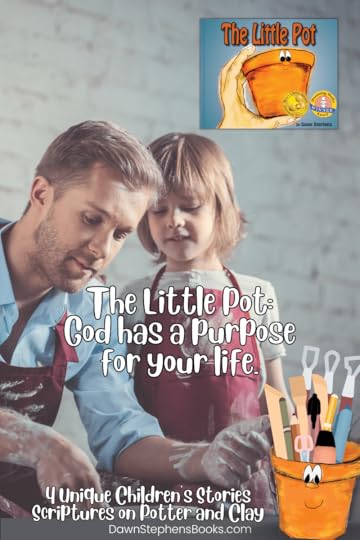 Scriptures on potter and clay come alive in the children’s book: The Little Pot.More Scriptures on Potter and clay
Scriptures on potter and clay come alive in the children’s book: The Little Pot.More Scriptures on Potter and clayRomans 9:20 But who are you, O man, to answer back to God? Will what is molded say to its molder, “Why have you made me like this?”
The Tea Pot: Serving othersThe Tea Pot is a heartwarming story about a little teapot who is selfish. In this story. Little Pot begins to believe that the Tea POt is better than it. We all struggle with comparing ourselves to others. That comparison leads to trying to solve our problems. Therefore, Little Pot and Tea Pot keep the tea and fruit. However, they discover that tea and fruit are meant for serving. The potter is a forgiving creator and prunes and washes the vessels. This story teaches children the importance of serving others and using their unique gifts and talents to help those around them. Learn about even more scriptures taught through this story here.
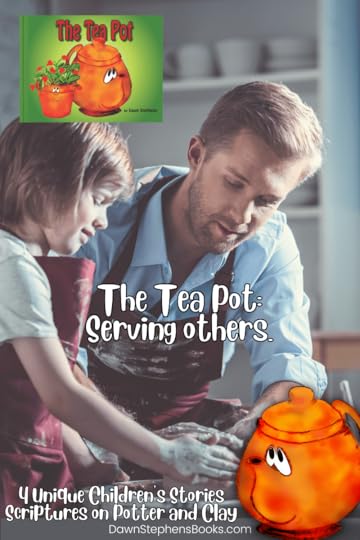 Children learn about serving others in this potter and clay book.Scriptures on Potter and Clay
Children learn about serving others in this potter and clay book.Scriptures on Potter and ClayEphesians 2:10 For we are his workmanship, created in Christ Jesus for good works, which God prepared beforehand, that we should walk in them. Matthew 5:16 In the same way, let your light shine before others, that they may see your good deeds and glorify your Father in heaven.
The Oil Lamp: Being brave enough to shine.The Oil Lamp is a story about a small oil lamp that is afraid to shine the light that the potter gives it. Other vessels feel offended and douse its flame. Likewise, it hides under a bowl. As a storm approaches, Tea Pot and Little Pot share their testimonies with the oil lamp and give it the necessary courage. This story teaches children the importance of being brave and using their talents to help others, even when scared or unsure. You can read more about how we let the light shine through us here.
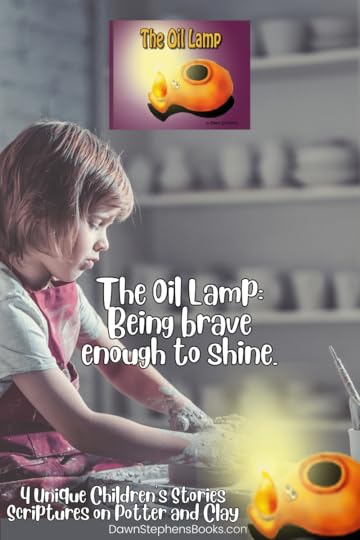 The Oil Lamp teaches children to be brave and shine for the potter.Burnout Fit In: Never giving up.
The Oil Lamp teaches children to be brave and shine for the potter.Burnout Fit In: Never giving up.Burnout Fit In continues the story. Oil Lamp is placed on a high pedestal to give light across the workshop. As it sits above the other vessels, it begins to run out of oil. Oil is a symbol of the Holy Spirit in the Bible. Likewise, it was used to anoint people as leaders. The potter makes sure that the little lamp gets the oil. However, it uses another vessel to distribute the oil to it. Amongst the ashes is a useless, cracked, and forgotten jar. The potter rescues this vessel and uses its wound to distribute oil to the lamp. It is designed to fit in the top of the lamp.
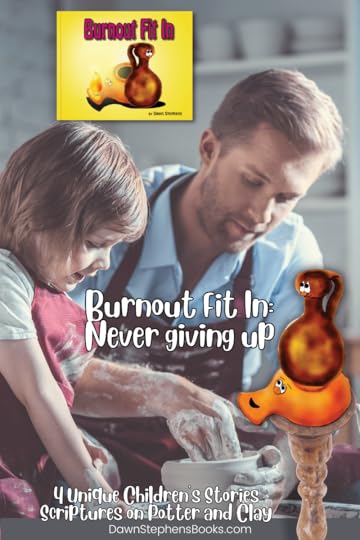 Burnout Fit In is a children’s book that brings potter and clay scriptures to life. It teaches kids never to give up.Author Dawn Stephens describes the book: Burnout Fit In
Burnout Fit In is a children’s book that brings potter and clay scriptures to life. It teaches kids never to give up.Author Dawn Stephens describes the book: Burnout Fit In  1. The Little Pot Picture Book $17.95 Add to cart
1. The Little Pot Picture Book $17.95 Add to cart  2. The Tea Pot Picture Book $17.95 Add to cart
2. The Tea Pot Picture Book $17.95 Add to cart  3. The Oil Lamp Picture Book $17.95 Add to cart
3. The Oil Lamp Picture Book $17.95 Add to cart  4. Burnout Fit In Picture Book $17.95 Add to cart Become a fruit-bearing vessel like Little Pot!
4. Burnout Fit In Picture Book $17.95 Add to cart Become a fruit-bearing vessel like Little Pot!As Little Pot, my unique purpose is growing fruit. Similarly, you have fruit to bear too. You produce the fruit of the Spirit (Galatians 5:22-23). I have developed a seven-step process allowing the potter to grow love, joy, peace, patience, kindness, goodness, faithfulness, and self-control through you. Just enter your first name and email so we can send you those seven steps. Additionally, you’ll get a fruitful Friday email each week with ways to be even more fruitful!
 Learn how the potter grows the fruit of the Spirit through you.
Learn how the potter grows the fruit of the Spirit through you.You can purchase these books here in our store, and they can be signed by the author specifically for your little graduate. The books are also available on Amazon.
Disclosure: The links above are affiliate links, meaning, at no additional cost to you, I will earn a commission if you click through and make a purchase.
The post 4 Unique Children’s Stories focused in Scriptures on Potter and Clay appeared first on Creative Teaching Resources and Inspirational Children's Books from Dawn Stephens books.
May 1, 2023
Happy Launch Day! A new children’s book picture book arrives today.
Happy Launch Day! It’s here! The day we’ve been waiting for. A new children’s picture book arrives today! The book is called Burnout Fit In. It’s the story of two vessels. One faces burnout, and the other learns that it fits in. In this new children’s book, literal words, allegories, and metaphors weave together to teach us essential spiritual truths.
Hi, I’m Little Pot. I’m a vessel created by the potter to grow fruit. You can read my story in the children’s book: The Little Pot. But today, we are celebrating another book. Burnout Fit In launches today!
This story started to form in March 2016. I traveled to Israel and began working on a story about an oil lamp. That story became a children’s picture book titled, The Oil Lamp. That book had a significant message about shining your light for the potter. As I began researching ideas for that book, God began planting seeds in me for another. Learning to shine for Jesus is essential. However, we sometimes don’t consider what it takes to keep shining. We might shine for a season, and then … then, we burn out.
 Happy launch day! A new children’s picture book is being released today.Unboxing the excellent news.
Happy launch day! A new children’s picture book is being released today.Unboxing the excellent news.As I considered this idea, God brought me on a journey. As my author, Dawn, continued to write about an oil lamp and the importance of shining, she was in a high leadership position at my church.
Likewise, The Oil Lamp book ends as the potter places the little vessel atop a lamp stand to shine for the other vessels. That is where God left Dawn and me too. She had a position over teachers, students, and parents. She sat above them and knew God wanted her to shine His light into their lives continually. As she did, she grew tired and constantly needed the Holy Spirit to refuel her. Likewise, the little oil lamp needed to be refueled too. Oil is a symbol of the Holy Spirit. Dawn regularly met with God and read her Bible. However, having the energy she needed some days was still challenging.
 Burnout Fit In is a new children’s book released today.Discover what’s inside for a happy launch day.
Burnout Fit In is a new children’s book released today.Discover what’s inside for a happy launch day.In the new children’s book Burnout Fit In, there are two vessels that the potter has plans for. The Oil Lamp sits in a position above the other vessels. It seemed that the potter created it not to need anyone. However, the story is also about another vessel. This vessel is a cracked jar that has been forgotten. It rolls under the table and sits amongst the ashes of the kiln.
Dawn’s time in that leadership position ended in 2020. She and her husband moved away and left their friends and church family behind. They moved for her husband’s job. Therefore, Dawn was not working except for writing more books. And she knew no one, just like the other vessel in this story; she wondered if the potter had forgotten her. She had scars and wounds from her previous positions, just like the cracked container.
As the story goes, the potter uses the damaged jar to replenish the lamp’s oil. The jar was designed to “fit in” the top of the oil lamp. And the crack was the very thing that let just the right amount of the oil seep into the lamp. The potter had always meant for the two vessels to work together and not be alone.
 Discover a new children’s book about two vessels that face burnout and learn to fit in.A new children’s picture book.
Discover a new children’s book about two vessels that face burnout and learn to fit in.A new children’s picture book.This book has been seven years in the making. Maybe not a full seven years of writing and illustrating. But, it has been a seven-year journey of the potter helping us understand how these little vessels felt and exactly how the potter was using them.
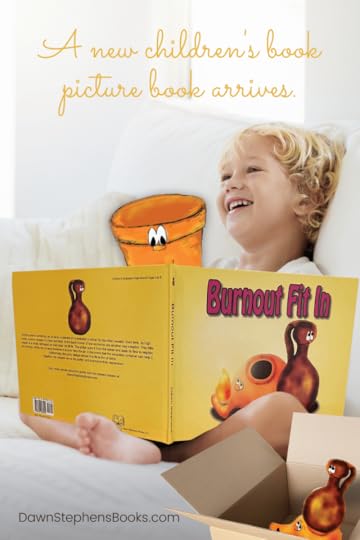 A new children’s book has arrived. Read Burnout Fit In with the Little Pot.Happy Launch Day to the book: Burnout Fit In
A new children’s book has arrived. Read Burnout Fit In with the Little Pot.Happy Launch Day to the book: Burnout Fit InIn conclusion, the oil lamp is facing burnout. It is running low on oil and needs the potter to replenish it. The potter does but in an unexpected way. He uses a forgotten cracked jar. The wound of this vessel filters the oil into the lamp so it can continue to shine. As you read this story, you will see that oil symbolizes the Holy Spirit. Likewise, you’ll understand that the potter’s vessels need each other. As bad things happen throughout life, wounds will be there to help others. That is why Burnout Fit In is a great way to help us all overcome loneliness.
Here’s a video explaining the book.
Become a fruit-bearing vessel like Little Pot!As Little Pot, my unique purpose is growing fruit. Similarly, you have fruit to bear too. You produce the fruit of the Spirit (Galatians 5:22-23). I have developed a seven-step process allowing the potter to grow love, joy, peace, patience, kindness, goodness, faithfulness, and self-control through you. Just enter your first name and email so we can send you those seven steps. Additionally, you’ll get a fruitful Friday email each week with ways to be even more fruitful!
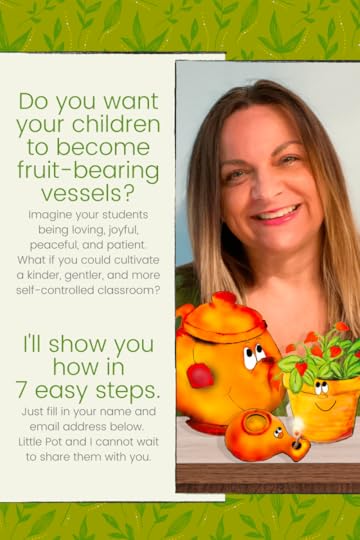
You can purchase these books here in our store, and they can be signed by the author specifically for your little graduate. The books are also available on Amazon.
Disclosure: The links above are affiliate links, meaning, at no additional cost to you, I will earn a commission if you click through and make a purchase.
The post Happy Launch Day! A new children’s book picture book arrives today. appeared first on Creative Teaching Resources and Inspirational Children's Books from Dawn Stephens books.
April 24, 2023
I’m so lonely. How to Overcome Loneliness, Be Found, and Fit in.
I’m so lonely and feeling lonely is a common experience for many people. It can be especially challenging for children. But there are ways to overcome loneliness and connect with others. This new children’s book offers helpful tips and strategies for combating loneliness and finding a sense of belonging.
Hi, I’m Little Pot I’m a vessel created by the potter to grow fruit. You can read my story in the children’s book: The Little Pot. Even though I know the potter uses me, sometimes I’m so lonely. Thankfully, there is new Children’s book about some friends of mine. And, they’ve helped me to understand this issue better.
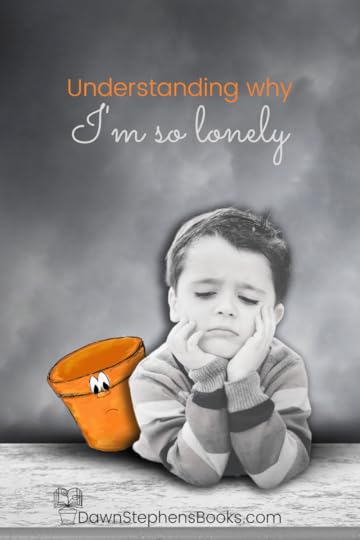 Little Pot, a fruit-bearing vessel created by the potter helps me understand why I’m so lonely.Understanding why I’m so lonely.
Little Pot, a fruit-bearing vessel created by the potter helps me understand why I’m so lonely.Understanding why I’m so lonely.Loneliness is a complex emotion that can be caused by a variety of factors. It can be the result of social isolation, a lack of meaningful connections with others, or a feeling like you don’t fit in, It can also be a symptom of underlying mental health issues, such as depression or anxiety. Understanding the root cause of your loneliness can help you develop effective strategies for overcoming it. You see, we were all created by a potter. And just as a child desires to have a relationship with his mother and father, we have a need to know our creator. The cool thing is that our creator desires to know us too.
God created a man and woman in His image for fellowship. He wanted to be in a relationship with them from the very beginning. You could even say that God was lonely. Therefore, he made people. Unfortunately, people disobeyed Him and broke the fellowship. They felt guilty. Their sin and new feelings of shame broke the fellowship they had with God. Additionally, the payment for sin was death. (Romans 6:23) However, God was not giving up on people. In fact, the rest of the Bible is the story of how God went to work to restore the relationship. Eventually, He sent his son, Jesus to Earth to pay the price and die for people’s sins.
When you have faith and believe Jesus is the son of God and died for you, your relationship with God is restored. Then, you will not feel as lonely because God gives His Holy Spirit to live inside you. You’ll have a friend with you at all times. Another great book to teach this concept is God’s Very Good Idea by Trillia Newbell and Catalina Echeverri.
 We need to connect to others so we will not feel lonely.Finding ways to connect with others so I’m not lonely.
We need to connect to others so we will not feel lonely.Finding ways to connect with others so I’m not lonely.Our creator doesn’t want us to only be in a relationship with him. He also wants us to connect with others. He has designed you to need other people and designed other people to need you. Discovering where you fit in amongst all the people in the world can make you feel lonely.
In the new children’s book, Burnout Fit In, there are two vessels that feel lonely. the first one is Oil Lamp. You can see how its story began in the book, The Oil Lamp. But, basically, the potter has given Oil Lamp a position above the other vessel. It sits high upon a pedestal. Because it is alone and above us, it feels lonely. It seems that the potter created to not need anyone. However, the story is also about another vessel. This vessel is lonely too. It is a cracked jar that has been forgotten. It rolled under the table and sits amongst the ashes of the kiln.
As the story goes, the potter uses the damaged jar to replenish the oil of the lamp. In fact, the jar was designed to “fit in” the top of the oil lamp. And, the crack was the very thing that let just the right amount of the oil seep into the lamp. The potter had always meant for the two vessels to work together and not be alone.
Be a part of Christ’s family.One of the most effective ways you can combat loneliness is to find ways that your creator designed you to connect with others. The best way to do this is to find a church. The church is God’s family and He has designed the people to function as His body (Romans 12:8). It’s important to remember that a body is made of many different parts. The parts each have unique functions but they all work together. By putting yourself out there and making an effort to connect with others, you’ll discover the way God designed you to help His body. In addition, you’ll overcome loneliness and build a fulfilling social life.
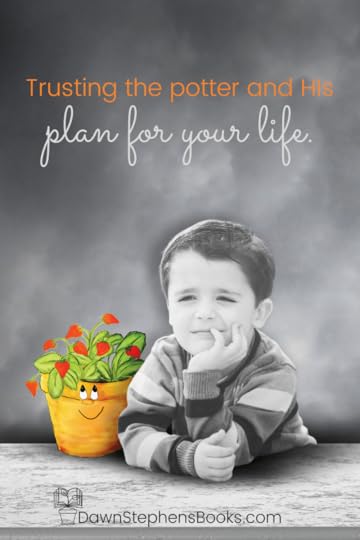 Trust in the potter’s plan when you feel lonely.Trusting the Potter, and His plan for your life.
Trust in the potter’s plan when you feel lonely.Trusting the Potter, and His plan for your life.When you say, “I’m so lonely,” it is easy to withdraw from others and God. That is only going to make you feel more lonely. Just like a potter molds and shapes clay into useful vessels, God is molding and shaping you into the person He wants you to be. It’s important to remember that even in times of loneliness, God is with you and has a purpose for your life. By trusting in Him and seeking His guidance, you can find comfort and peace in knowing that you are never truly alone.
The book Burnout Fit InIn the book, the oil lamp is facing burnout. It is running low on oil and needs the potter to replenish it. The potter does but in an unexpected way. He uses a forgotten cracked jar. The wound of this vessel filters the oil into the lamp so it can continue to shine. As you read this story, you will see that oil symbolizes the Holy Spirit. Likewise, you’ll understand that the potter’s vessels need each other. As bad things happen throughout life, wounds will be there to help others. That is why Burnout Fit In is a great way to help us all overcome loneliness.
Here’s a video explaining the book.
Become a fruit-bearing vessel like Little Pot!As Little Pot, my unique purpose is growing fruit. You have fruit to bear too. The fruit you grow is the fruit of the Spirit (Galatians 5:22-23). I have developed a seven-step process allowing the potter to grow love, joy, peace, patience, kindness, goodness, faithfulness, and self-control through you. Just enter your first name and email so we can send you those seven steps. Then you’ll get a fruitful Friday email each week with ways to be even more fruitful!

You can purchase these books here in our store, and they can be signed by the author specifically for your little graduate. The books are also available on Amazon.
Disclosure: The links above are affiliate links, meaning, at no additional cost to you, I will earn a commission if you click through and make a purchase.
The post I’m so lonely. How to Overcome Loneliness, Be Found, and Fit in. appeared first on Creative Teaching Resources and Inspirational Children's Books from Dawn Stephens books.
April 16, 2023
What to get a kindergartener for graduation. Four books they will really love.
What to get a kindergartener for graduation can be a daunting decision. You want something they will really love. You also want a timeless keepsake. Additionally, it should be special to them throughout their school years. Five and six-year-olds love these books. Likewise, the message will continue to speak to them from first through twelfth grade.
 These books are what you should get a kindergartener for graduation.The Little Pot is what to get a kindergartener for graduation.
These books are what you should get a kindergartener for graduation.The Little Pot is what to get a kindergartener for graduation.The potter creates a vessel in the inspirational children’s book, The Little Pot. This vessel is eager to discover its purpose. With each item it holds, it wonders if this task is its purpose. Holding papers makes it feel smart. Holding coins makes the little pot feel rich. However, both items are not what the potter allows the clay vessel to keep. Then, the potter puts dirt inside the little pot. The clay vessel now wonders even more what its purpose is. Unbeknown to the little vessel, the potter has planted something in the soil, and it is beginning to grow something inside. Eventually, the plant blooms beautiful flowers. Is its purpose to be pretty? Not exactly. The flowers do not last. Ultimately, they turn to fruit, and the vessel realizes its purpose does not come from what it holds but from what is produced.
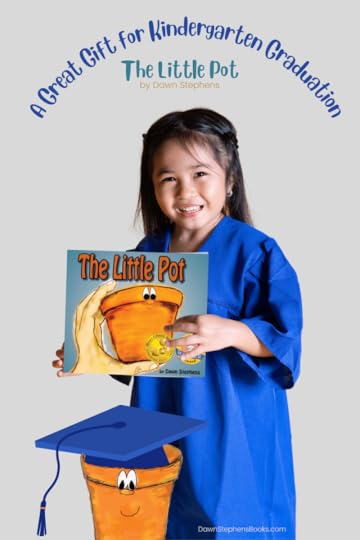 The Little Pot book makes a great gift.
The Little Pot book makes a great gift.The little pot becomes a vessel to grow fruit. Your kindergartener or preschooler is like Little Pot because he/she is also a vessel made by the potter, God, to grow the fruit of the Spirit. Consider giving The Little Pot book when searching for the best gifts for kindergarten graduation.
The Tea Pot is what to get a kindergartener for graduation.Another book that makes a great kindergarten graduation gift is The Tea Pot. In this book, the potter grows fruit through Little Pot as he makes more vessels from clay. As other vessels are made, Little Pot watches and begins to compare himself to them. One day the potter makes a vessel that will serve a different purpose. It is a teapot. As the potter makes tea inside this vessel, Little Pot wonders if the teapot is better. The teapot makes delicious tea. However, the vessels become frustrated when the potter continually pours out the liquid and picks the fruit. Selfishly, they want to keep their fruit and tea. The Potter allows it. Eventually, the fruit rots, and the tea spoils. Finally, the vessels realize they need the potter and ask him to clean and prune them. He does, and the vessels can now serve others.
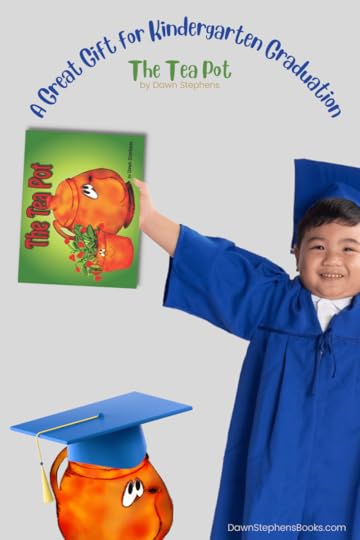 The Tea Pot book makes an excellent gift for a kindergartener.
The Tea Pot book makes an excellent gift for a kindergartener. Your kindergarten graduate is like Tea Pot and Little Pot in this story because they were created to serve others.
The Oil Lamp is an excellent kindergarten graduation gift.In the third inspirational children’s book, Tea Pot and Little Pot, have learned to serve the potter and others. Likewise, their relationship with the potter continues to grow. Then a potter creates a small oil lamp. The purpose of this vessel is to shine a light on the other vessels. The potter knows that a storm is coming and light is needed. The new clay vessel, however, is too shy to shine its light and hides under other vessels. When it finally does become bold enough to shine, it flares up and burns the other vessels. After hearing the testimonies of Little Pot and Tea Pot, the oil lamp has the faith it needs to shine brightly for the potter.
 The Oil Lamp book makes a great gift.
The Oil Lamp book makes a great gift.Through this book, your kindergartener or preschool graduate can learn to be like Little Pot and Tea Pot and share their testimonies with others. They also will learn to be like Oil Lamp and shine the light that the potter, God, gives them. That is why these books make excellent gifts for kindergarten graduation.
Burnout Fit In is what to get a kindergartener for graduation.Finally, the fourth book is a brand new edition to the series. It is being released on May 1, 2023.
 Burnout Fit In is what to buy a kindergartener or preschooler for their graduation gift.
Burnout Fit In is what to buy a kindergartener or preschooler for their graduation gift.In this brand-new book, the oil lamp is facing burnout. It is running low on oil and needs the potter to replenish it. The potter does but in an unexpected way. He uses a forgotten cracked jar. The wound of this vessel filters the oil into the lamp so it can continue to shine. As your kindergartener or preschooler grows up with this story, they will understand that oil symbolizes the Holy Spirit. Likewise, they learn that they need others around them to keep shining. As bad things happen to them throughout their life, they will also recognize that those wounds can help others. That is why Burnout Fit In is a what to get a kindergartener for graduation.
Here’s a video explaining the book.
Become a fruit-bearing vessel like Little Pot!Being a fruit-bearing vessel is more difficult than reading a children’s picture book. That is why I have developed a seven-step process allowing the potter to grow love, joy, peace, patience, kindness, goodness, faithfulness, and self-control through you. Just enter your first name and email so we can send you those seven steps. Then you’ll get a fruitful Friday email each week with ways to be even more fruitful!
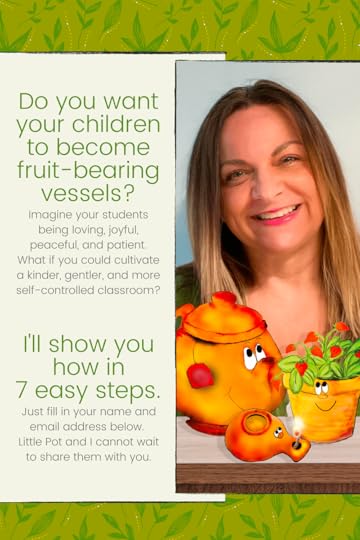
You can purchase these books here in our store, and they can be signed by the author specifically for your little graduate. The books are also available on Amazon.
Disclosure: The links above are affiliate links, meaning, at no additional cost to you, I will earn a commission if you click through and make a purchase.
The post What to get a kindergartener for graduation. Four books they will really love. appeared first on Creative Teaching Resources and Inspirational Children's Books from Dawn Stephens books.

